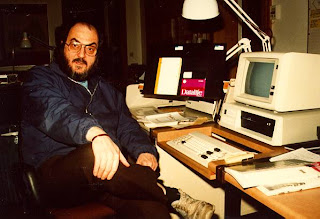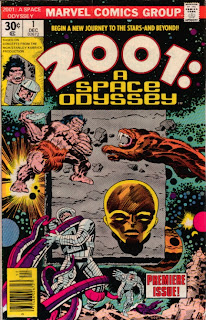
This is the 24 page Japanese film program for BARRY LYNDON. The program was available for sale in Japanese theatres during the films initial run in 1976.














 The exhibition, Taming Light, featuring the work of 25 artists drawing inspiration from the films of Stanley Kubrick, will be held in the Lighthouse Cinema from 1st-31st October. It is currated by film critic John Maguire & the poster for the show was designed by Montevideo based illustrator Martin Ansin.
The exhibition, Taming Light, featuring the work of 25 artists drawing inspiration from the films of Stanley Kubrick, will be held in the Lighthouse Cinema from 1st-31st October. It is currated by film critic John Maguire & the poster for the show was designed by Montevideo based illustrator Martin Ansin.

 This portrait of the Torrances by artist Kirk Demarais is one of several based upon familiar film families & is currently being exhibited at the annual Crazy 4 Cult art show at Gallery 1988 in Los Angeles. This piece is being offered by the gallery this year as a signed limited edition print of 50 for $65. You can call the gallery to order a print on + 1 (415) 4091376 (their San Francisco location) or + 1 (323) 9377088 (their Los Angeles location) or email them at Gallery1988@aol.com. The full show, featuring many other Kubrick themed works, can be seen here.
This portrait of the Torrances by artist Kirk Demarais is one of several based upon familiar film families & is currently being exhibited at the annual Crazy 4 Cult art show at Gallery 1988 in Los Angeles. This piece is being offered by the gallery this year as a signed limited edition print of 50 for $65. You can call the gallery to order a print on + 1 (415) 4091376 (their San Francisco location) or + 1 (323) 9377088 (their Los Angeles location) or email them at Gallery1988@aol.com. The full show, featuring many other Kubrick themed works, can be seen here.







 In March 2004 THE GUARDIAN WEEKEND magazine published Jon Ronson's account of his many months spent investigating the contents of Kubrick's archive, then still residing at his home in Childwick, before it's subsequent move to the University of the Arts London. Presented here are Stephen Gill's photographs which originally accompanied the article, the full text of the feature can be read here.
In March 2004 THE GUARDIAN WEEKEND magazine published Jon Ronson's account of his many months spent investigating the contents of Kubrick's archive, then still residing at his home in Childwick, before it's subsequent move to the University of the Arts London. Presented here are Stephen Gill's photographs which originally accompanied the article, the full text of the feature can be read here.







 In January 1984 Kubrick engaged American computer expert Alan Bowker to install an early IBM XT PC in his office during the pre-production on Full Metal Jacket. Kubrick's main interest was in using the then available technology for word processing and database manipulation. Alan took these photos and can also be seen operating the IBM XT in a picture taken by Kubrick.
In January 1984 Kubrick engaged American computer expert Alan Bowker to install an early IBM XT PC in his office during the pre-production on Full Metal Jacket. Kubrick's main interest was in using the then available technology for word processing and database manipulation. Alan took these photos and can also be seen operating the IBM XT in a picture taken by Kubrick.
 The ongoing 2001 comic book series was already in the works when Kirby's film adaptation was released. The short lived 10 issue title, which ran from December 1976 to September 1977, was certainly far from the norm in mid-seventies comicdom as was it's two-fisted pugilist style from Kubrick's sedate story telling grandeur. As an official spin-off from Kubrick's master work it could be considered a failure but as an extension of Kirby's early seventies far-out world view, as seen previously in the Forever People, it was an admirable achievement. The tenuous links with the film had petered out by issue 8 with the introduction of the character Mister Machine, an obvious Marvel ploy to boast flagging sales. This character eventual became Machine Man with his own title in 1978, thus ensuring that 2001 & everything Kubrick created for his film became part of the on-going Marvel universe cannon. 'Nuff said!
The ongoing 2001 comic book series was already in the works when Kirby's film adaptation was released. The short lived 10 issue title, which ran from December 1976 to September 1977, was certainly far from the norm in mid-seventies comicdom as was it's two-fisted pugilist style from Kubrick's sedate story telling grandeur. As an official spin-off from Kubrick's master work it could be considered a failure but as an extension of Kirby's early seventies far-out world view, as seen previously in the Forever People, it was an admirable achievement. The tenuous links with the film had petered out by issue 8 with the introduction of the character Mister Machine, an obvious Marvel ploy to boast flagging sales. This character eventual became Machine Man with his own title in 1978, thus ensuring that 2001 & everything Kubrick created for his film became part of the on-going Marvel universe cannon. 'Nuff said!







